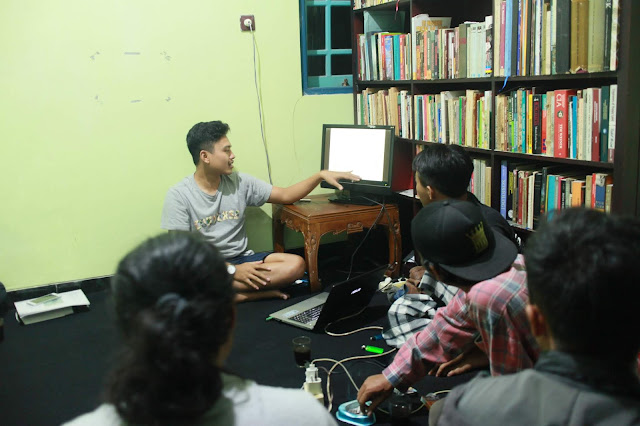Another stone Inscription besides Plumpungan in Salatiga
After I finished my bachelor
degree in almost three years ago, I do not have a further plan relating to my career.
I just want to continue my study to master degree in overseas university. However,
it took a great deal of time to wait for geting a sholarship, therefore I
though that It is better during waiting such an opportunity I create a valuable
activity in Salatiga. In this month, I modificated my bed room to be a small
library and meeting room for public. In this space, all of my books collection
can be accessed. I though that it is the important part for the society in a
town like Salatiga to has a new sources of books relating to the History and Culture
of Indonesia.
In 22 July 2018, two days before Salatiga
celebrated 1268 anniversary, I formed a forum to discuss about the inscription
from 750 C named “Plumpungan” which become a basic of determination of
Salatiga’s date of birth. I send an invitation to everyone who want to joint
this forum through Instagram story, I though that not many youngsters had a
desire to talk about history, however there were 13 people who came to this discussion.
It amazed me since it was the first time
I created a discussion forum of history
and culture in Salatiga and the response was so amazing.
This discussion started at 19.30
that was opened by a documenter film that I made with the film community in
Salatiga in 2011. Then, I explained about several new sources that I was found
in some literatures that was published in 1891 and 1915. Both literatures were
fascinating since the author could explain another inscription in Salatiga
besides “Plumpungan”. The literature that was published in 1915 written by Campbell
explained that the name Salatiga came from three stones which showed an
inscription and number 1330 and 1363 as a Caka year. The argument of Cambell
was supported by Nijhof- The author of Verhandelingen
van Het Bataviaasch Genootschap that was published in 1891. Nijhof said
that one of the stone inscription that located near Tadjoeh village has been
picked up to the museum of Batavia in that time. Unfortunately, today I do not
know where is the Tadjoeh village is since I never hear before about the this
area.
Several guests who came to this
room also shared about their information relating to some relics from Hindu and
Budha era that spread in surrounding Salatiga (Ngentak, Pancuran, Turusan,
Senjaya). From the information of the guest I could analize that Hindu and
Budha had a special position to the local society in Salatiga in that time. However,
How could the civilization of the Hindu and Budha was lost in Salatiga?? There is
no information relating to this fact. I tried to analize it, the position of Salatiga
is in the foothills of Merbabu mountain, and the common accident which can
demolish a tangible heritage was mountain eruption. Therefore, I tried to
search information about when Merbabu actived in the past? Then I found that
this mountain was actived and exploded in 1560 and 1797.
I guess that the first explotion
was the bigest one that destroyed the tamples and another Hindu relics in
Salatiga. Morover, H. D Graff reveal in his journal the titled De verdwenen tjandi te Salatiga or The
lost temple in Salatiga that Trading company of Dutch named VOC build their
third fort was in Salatiga. In this journal, De Graff explained that the ruins
of the temple that was founded by VOC in Salatiga was used as a material to
built Fortress the Hersteller (Salatiga fortress), then the location was in
around Ramayana supermarket in Salatiga nowadays.
In the final part of this
discussion, we agree that there is an another stone inscription besides
Plumpungan in Salatiga so that we have a homework to find tadjoeh village where
another inscription was located.
Thank you for being a reader of my blog.
BIG HUG
Abel Jatayu Prakosa
SALATIGA- a cup of Nusantara, 1 august 2018






Lovely library. I saw it on monday.
ReplyDelete